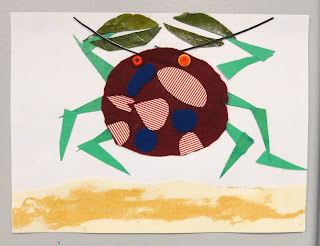Milk Jug Masks
There are so many possibilities when using milk jugs as the armature for a mask, and of course, there are many types of masks to make. I did this project with 4th gr. We discussed the idea of masks, and looked at different types, from animal, African, masquerade, Chinese, and also "fantasy" masks. I prepared and set out a variety of materials the students could use.
The major key to success in this project is to have the students brainstorm and draw a sketch of the mask they would like to make. It could be just about any type of mask, but insist that once the sketch is done, they must stick to that idea and not change their minds later. Otherwise, you will have many wasted materials.
Materials:
1. Gallon milk jugs, cut with scissors halfway down, with the handle side being used for the mask. You can save the other plastic and cut into strips or other shapes to use with the mask. The beauty of these jugs is that it is easy to cut and punch holes using a hole punch and scissors
2. Colored tissue paper
3. Glue and water
4. Paint
5. Materials such as plastic bottle caps, felt, fun foam, feathers, sequins, wire, raffia, pom poms, beads, fabric, chenille stems, and whatever else you can think of!
6. Tacky glue
Procedure:
1. Make sure that students have done a sketch with a completed idea for a mask. I allowed them to do any type of mask they wished (within reason) but if you want to keep it to a theme, that works too. I provided a pre-drawn drawing of an outline of the shape of the mask to make it a little easier for them to visualize the shape of the mask. Emphasize that the mask front can be with the spout part up or down. Once the sketches are done, keep them and let students use them for reference. Once again, insist that they stick with their original idea. They can add to it as they go along or slightly modify it, but many times they will want to completely change their idea, once they see the different materials set out. This results in wasted materials and a mask that is not good quality.
2.Have them write their name with marker on the underside of the mask. They will choose a colored tissue paper, tear it into strips and glue onto the jug, covering entirely and smoothly. You may also use newspaper.
3.Once dry, they may paint the mask any way they wish that fits with their idea.
4. Adding designs, features and embellishments- I have found it works best to set out only the paint for one or two days, and wait for everyone to finish that step before you move on to the next step. There can be so many materials for this project, that the students can get overwhelmed by the choices if you set them out all at once.
5. Give them a paper plate or a little bowl for each student to put her/his supplies in. Set them all out on a table, and they can choose what they want to use, and keep it in their bowl for next time. It helps to make sure one or a few students don't take more of a supply than they really need.
6. You can punch holes in the plastic to tie wire, raffia, or chenille stems to the mask. Bottle caps with glass beads can be used for eyes.
It is so much fun to see their ideas!


















